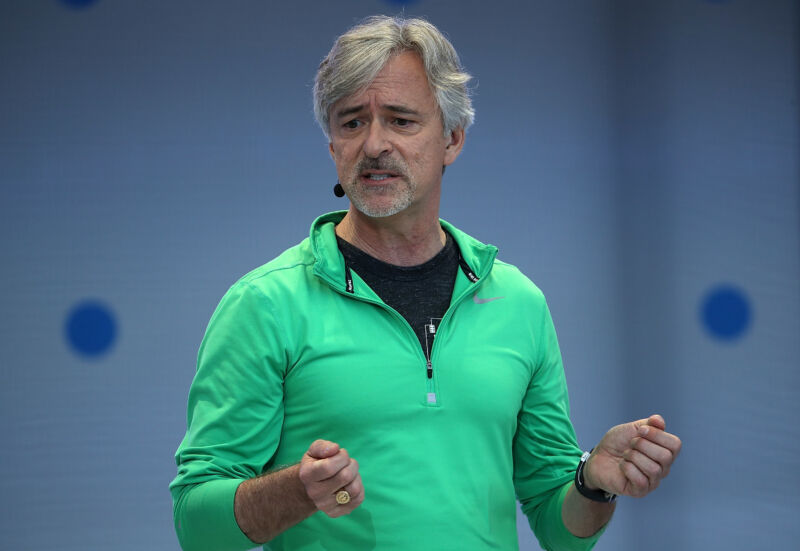A tale of two strategies —
Elon Musk and John Krafcik have very different theories about driverless tech.
Timothy B. Lee
–

Enlarge / Waymo CEO John Krafcik speaks in 2018.
Justin Sullivan/Getty Images
Many Tesla fans view the electric carmaker as a world leader in self-driving technology. CEO Elon Musk himself has repeatedly claimed that the company is less than two years away from perfecting fully self-driving technology.
But in an interview with Germany’s Manager magazine, Waymo CEO John Krafcik dismissed Tesla as a Waymo competitor and argued that Tesla’s current strategy was unlikely to ever produce a fully self-driving system.
“For us, Tesla is not a competitor at all,” Krafcik said. “We manufacture a completely autonomous driving system. Tesla is an automaker that is developing a really good driver assistance system.”
For Musk, these two technologies exist along a continuum. His plan is to gradually make Tesla’s Autopilot software better until it’s good enough to work with no human supervision. But Krafcik argues that’s not realistic.
“It is a misconception that you can just keep developing a driver assistance system until one day you can magically leap to a fully autonomous driving system,” Krafcik said. “In terms of robustness and accuracy, for example, our sensors are orders of magnitude better than what we see on the road from other manufacturers.”
This isn’t a new argument.
Tesla keeps missing Musk’s predictions
Tesla has a lot riding on its efforts to develop fully self-driving technology. Since 2016, Tesla has been selling cars with a suite of cameras, radar, and other hardware that it has touted as ready for full self-driving with a future software update. The same year, Tesla started charging thousands of dollars for a “full self-driving” software package that was supposed to be delivered later.
If Tesla can’t deliver fully autonomous software, it’s going to have a lot of angry customers. Musk initially predicted that this technology would be ready by 2018, but he’s repeatedly pushed back the timeline.
Last October, Tesla finally released a beta version of its “full self-driving” software to a selected group of Tesla customers. Where earlier versions were limited to certain driving environments—primarily highways—the FSD beta was designed to handle most common road and intersection types. It could stop for stop lights, make left turns, and navigate roundabouts.
But the software was clearly not ready for wide release. I watched a few hours of early unedited footage posted by Tesla owners who received the new software. The software made a number of mistakes, including two incidents where a Tesla seemed to be on the verge of colliding with another vehicle before the driver intervened.
Tesla, of course, is working to fix these issues and improve the software over time. Musk believes that before too long, the software will be good enough that it can operate without active human oversight. And not long after that, it will be good enough to operate completely autonomously—with no one in the driver’s seat or even in the car at all.
Waymo rejected Tesla’s strategy years ago
But Waymo’s leaders have long doubted that premise. They believe that lidar sensors will be indispensable to get early self-driving vehicles on the road. They also believe that the transition from a driver-assistance system to a fully driverless system is fraught with danger.
The Waymo team believes its own early experience—when it was the Google self-driving car project—bears that out. In the early 2010s, Google developed a driver-assistance system similar to today’s Autopilot and considered selling it to automakers. But when they let Google employees test the software on public roads, they found that drivers came to trust it way too quickly. Drivers who were supposed to be closely monitoring the system instead spent their time looking at their phones, putting on makeup, and other distractions.
The fundamental challenge here is that the better a driver-assistance system gets, the harder it is to get drivers to pay attention, and the less likely they are to be prepared if the software makes a mistake. The Google team didn’t see a good solution to this problem, so they completely changed their strategy. They focused on building a self-driving taxi service that would never have customers in the driver’s seat, relying on trained, professional safety drivers to oversee the software during testing.
Krafcik says that Waymo has largely completed technical work on its self-driving software and is now focused on scaling the technology up. If that’s true, the company may be able to demonstrate the technical and commercial viability of its approach in the next couple of years. Musk has dismissed Waymo’s approach as a “highly specialized solution” and questioned whether Waymo can scale it up.
Meanwhile, despite the repeated failures of his past predictions, Musk continues to insist that Tesla’s full self-driving technology is close to release. “I am extremely confident of achieving full autonomy and releasing it to the Tesla customer base” in 2021, Musk stated last month. Krafcik, meanwhile, believes Tesla’s approach is a dead end.
In the next couple of years, we may finally find out whose theory is right.

